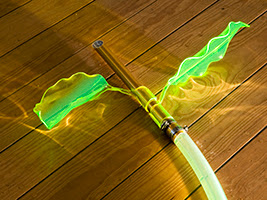ART REVIEW: "Thomas Glassford: Afterglow"; "Living As Form (Nomadic Version)"-Moore College of Art and Design
Recently,
I decided to leave the Swarthmore bubble for our exciting nearby urban
metropolis of Philadelphia. Since it is my goal to know my way around the
downtown area like a local, I decided I would visit the somewhat lesser known
Galleries at Moore College of Art and Design on the Benjamin Franklin Parkway,
near the Philadelphia Museum of Art, the Free Library, the new Barnes
Collection, and many more attractions. After disembarking at Suburban
Station and wandering around Rittenhouse Square eating my lunch, I made my way
over to the Galleries at Moore.
Moore
College of Art and Design, located in an unassuming building on the Parkway, is
a women’s art college with several galleries. When I visited, I saw two
shows in these galleries. The overall experiences I had in each exhibit
were varied.
(moore.edu)
The
other gallery I visited, the Goldie Paley Gallery, hosted a much more
thought-provoking exhibit. In contrast to the more makeshift setting of
the Glassford installation, the Goldie Paley Gallery is a closed-off space and
there was plenty of available information about the show, which was necessary
due to the works’ complexity. Titled “Living As Form (The Nomadic
Version)”, this exhibit brought together artists and curators from all over the
world, who, over a period of more than twenty years, created works in a variety
of media that “blur art and everyday life”. The various posters, videos
and photographs on display all sought to capture moments from ordinary lives
from around the world. The ordinary, placed in this gallery context,
became art to the viewer. Does art imitate life, or does life imitate
art? The viewer sees it as art because
of its context. In one noteworthy case, everyday life for people in a
small Czech village became in and of itself a sort of performance art.
Namely, as described in the piece titled “There is Nothing There”, an artist
helped organize a system by which the 350 inhabitants of said village conducted
their everyday lives in perfect synchronization.
This
exhibit raised some penetrating issues for me as an art viewer and
enthusiast. Several of the works, including photos of the 2011 Tahrir
Square protests, a photo essay about the revitalization of a hillside village
in Puerto Rico, and a small installation detailing architectural plans for the
modification of an old military base in the West Bank were unsettling in
particular. These works aren’t just depictions of everyday
life. For the people in the artwork, these works are everyday life.
The viewer in a Philadelphia gallery will experience these people’s everyday
realities as something affixed to a wall, and I must admit that I felt like a
voyeur during this exhibition. All art appreciation is inherently
voyeuristic, but this commodification of the everyday struggles of people
around the world was more unsettling to me than other exhibits have been. Therein
lies the danger in this sort of documentary of everyday life presented as
art.
A video, entitled “Complaints Choir”, summarized the works in a manner that I believe conveyed the curators’ intentions for the exhibit. This work, by Finnish artists, showed people all over the world singing in practiced arrangements about their complaints, problems and everyday annoyances, from the mundane, such as bad drivers, to the more meaningful, as such sexuality. The pure sonic beauty of the singing drew a humorous contrast to the subjects being sung about. The video was very effective because it emphasized and interconnected all people’s commonalities, highlighting our basic humanity: everyone has petty grievances, everyone complains about something, everyone is plagued with questions about life.
This
exhibit is consuming and a bit unsettling when one contemplates its treatment
of people’s lives for our own consumption. I have only touched upon a few
components of the exhibit; it’s worth a trip to Philly to see both and
experience them for yourself. Both exhibits run until March 16.

Certainly two unusual exhibits in this review - both seem to be thought provoking in their own ways. Qualifying something as art has never been easy. I like that you saw works that pushed your definitions a bit. I also love that you are exploring lesser known locales. But to really be a "local" you gotta enjoy a cheesesteak!
ReplyDelete